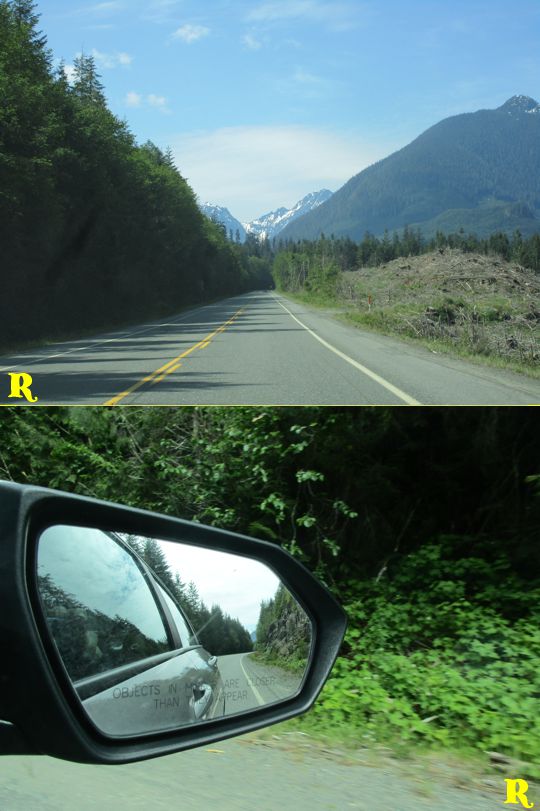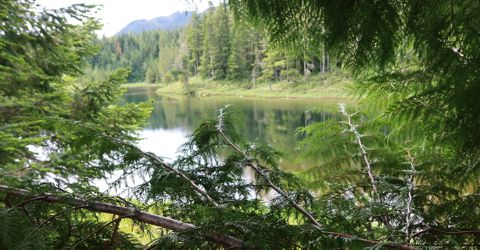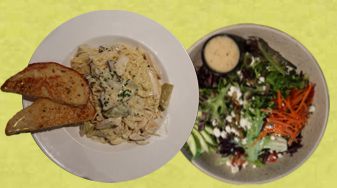| itinerary < 1 June Campbell River, B.C. Port Hardy > | Port Hardy 2 June 2023 |
|
We have arrived at our departure point, and are settled into a 4-star hotel room in a First Nations-run property, Kwa'lilas Hotel. (Kwa'lilas is the kwak’wala word used by Gwa’sala-‘Nakwaxda’xw people, meaning 'a place to sleep.') Today was an easy travel day . . . but curious. As I guessed yesterday, Campbell River is the far north point on B.C.'s 'Discovery Coast.' North of Campbell River, one has left 'Super! Natural!' British Columbia and is in the land of endless trees and all the privileges appertaining thereto. Miles and miles and miles of two-lane highway with an endless 'visual barrier' of big second growth trees guarding travelers from seeing the rapine behind . . . most of the time.
This part of the temperate rain forest is unbelievably green, and where the trees haven't been 'harvested' – the proper silvicultural term – the road runs between walls of hundred-plus foot trees, mostly firs, but intermixed with spruce and other species. The original forest is thought by experts to be one of the most varied forests on the planet, meaning also one of the oldest. Where the trees have been taken and the land has been replanted, the plantings are typically chosen for marketability, meaning fast growth but without due regard for what the land wants to grow . . . despite good research by local expert silviculturists like Suzanne Simard. Their work shows that diverse planting in accord with what was there originally encourages re-establishment of a true forest, not a tree farm. Of course the argument goes on, between the quick profiteers (who heretofore usually win in B.C.) and those who favor some form of sustainability. |
 |
 |
We stopped here, some two hours into today's drive (1) because there was a pullout, and (2) we wanted to stretch our legs. A bushy haired gentleman emerged from the bushes with camera in hand, and said, 'You can't really see the lake unless you go down a dodgy path.' I did (partway) and saw this: Â  |
|
 |
 |
We keep getting a strong sense of being outside the bounds of British Columbia's enthusiastic self-promotion as “Super! Natural!†The business here is trees, not tourism, the careful walling of the highway from the clearcuts notwithstanding. Almost every lower slope has been thoroughly abused . . . and yet how can we, who live in wooden house and love the fact that wood is such a wonderful medium for making things, object? Sure, there may be better ways to 'take' trees, but wouldn't we object to the increased cost of our favorite building material? Â
  Moving right along; don't these mountains remind you of New Zealand's 'Alps'? The 'Super! Natural!' flaks are sitting on hidden gold here, but don't seem to pay it any attention. (I doubt they've ever been north of Nanaimo.) Do the folks who drive past Campbell River on Highway 19 only want to 'get there' without enjoying the journey? Not us. We finally found a barren pullout with a view to the Inland Passage and the snowy mountain range on the mainland. |
 |
|
More about Port Hardy and environs tomorrow. The fancy in-house restaurant, Ha'Me' (meaning 'food' in kwak’wala) is 'under renovation,' so we ate pub food at Nax'id (kwak’wala for 'drink): good chicken alfredo, a nice green salad, yummy Pear Cider from Okanagan, and a sinful piece of chocolate cake. Attentive, friendly service despite Friday night's chaos.
 |
 |
updated 16 June 2023 Caspar Time site software and photographs by the Caspar Institute except as noted this site generated with 100% recycled electrons! send website feedback to the CI webster © copyright 2002-2024 Caspar Institute |